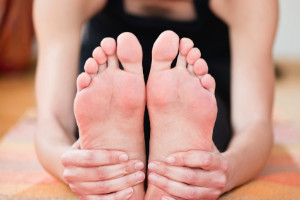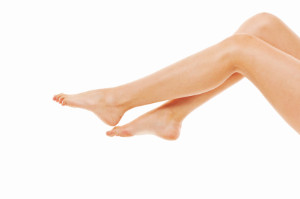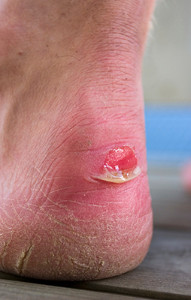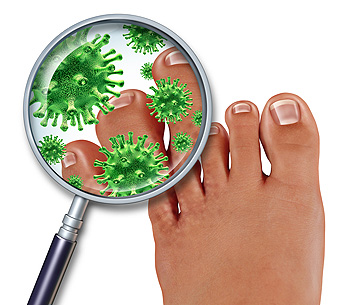
Wilmington (937) 382-2347
Fax
(513) 932-1606

Wilmington (937) 382-2347
Fax
(513) 932-1606
Debilitating foot pain is a problem for many people. But just as stretching the torso can help alleviate back pain, stretching the feet can also help mend existing foot problems and prevent future ones.
The feet, as the body’s foundation, carry the body’s entire weight and can get easily strained from overexertion. Persistent sharp pain and cramping in the feet are often common concerns. Foot pain and foot problems can be due to any number of causes, and in many cases pain may be eased without medication or doctor visits. It is always a good idea, however, to first rule out any serious medical issues with a physician.
Stretching can help relax the feet and alleviate pain, but is especially important before heavy aerobic exercise. Stretching before such activities can help you avoid experiencing painful cramps or strained foot muscles. Stretches should be performed slowly and deliberately without forceful pulling. The stretch should be held for several seconds before relaxing.
A great way to stretch out and loosen up the foot muscles while sitting is to cross one leg over the other and pull the toes carefully back without overextending. Start by resting the left ankle on the right knee. With the left hand, gently flex the left foot by pulling back on the toes. Do not pull too hard; just hard enough to feel the stretch in the arch of the foot. Then point the toes of the left foot as far as you can. Rotate the motion of pointing with pulling back on the toes. This should relax and stretch the muscles on the bottom and the top of the foot. Doing this stretch ten to twenty times should bring relief. Repeat the whole process for the other foot by resting the right ankle on the left knee.
A stretch that focuses on the often injured Achilles tendon involves standing and facing a wall with your arms out and hands flat against the wall. Step back with one foot, keeping it flat against the floor. Move the other leg forward and lean toward the wall. You should feel a stretch through the back of your leg and your Achilles tendon, but do not push yourself too much. Stop when you feel a stretching sensation, and hold for 30 seconds. Ten repetitions may be done for each foot.
Stretching the feet is important for athletes or those performing aerobic exercise, but it can also help anyone with foot pain caused by poor footwear, plantar fasciitis, or long hours standing and walking. Individuals who tend to their feet by regularly stretching every day should be able to minimize foot pain and prevent new problems from arising.
 General health is often improved by stretching and exercising your feet on a routine basis. While walking may be the most beneficial exercise, flexibility and resistance exercises can be just as important in promoting good health and avoiding injury to the feet. There are many forms of exercise to choose from, many of which can be integrated into your daily routine. Before beginning, it’s important to allow time for simple stretching; this can help in strengthening the muscles of the feet. Some exercises may include circling your foot in one direction, then changing to the other direction. Dropping the heel while standing on a step is another effective stretch for the feet. It's important to remember to contact your podiatrist if you experience pain at any time during these stretches.
General health is often improved by stretching and exercising your feet on a routine basis. While walking may be the most beneficial exercise, flexibility and resistance exercises can be just as important in promoting good health and avoiding injury to the feet. There are many forms of exercise to choose from, many of which can be integrated into your daily routine. Before beginning, it’s important to allow time for simple stretching; this can help in strengthening the muscles of the feet. Some exercises may include circling your foot in one direction, then changing to the other direction. Dropping the heel while standing on a step is another effective stretch for the feet. It's important to remember to contact your podiatrist if you experience pain at any time during these stretches.
Stretching the feet is a great way to prevent injuries. If you have any concerns with your feet consult with Dr. Gerald Perelman from Ohio. Our doctor will assess your condition and provide you with quality foot and ankle treatment.
Stretching the Feet
Being the backbone of the body, the feet carry your entire weight and can easily become overexerted, causing cramps and pain. As with any body part, stretching your feet can serve many benefits. From increasing flexibility to even providing some pain relief, be sure to give your feet a stretch from time to time. This is especially important for athletes or anyone performing aerobic exercises, but anyone experiencing foot pain or is on their feet constantly should also engage in this practice.
Great ways to stretch your feet:
Individuals who tend to their feet by regular stretching every day should be able to minimize foot pain and prevent new problems from arising.
If you have any questions, please feel free to contact our office located in Wilmington, OH . We offer the newest diagnostic and treatment technologies for all your foot care needs.
An ingrown toenail is a toenail that grows sideways into the nail bed, causing pain and swelling. Ingrown toenails can worsen and cause drainage, turning into a serious infection.
Several factors affect whether a person is at risk from an ingrown toenail. The many causes include being overweight, diabetes, participating in sports, having a fungal infection of the toe, and cutting your nails too short. Ingrown toenails also have a genetic predisposition, causing some people to be more prone to receive the condition than others. Other causes include improperly fitting shoes and shoes that keep the feet damp.
Ingrown toenails can be preventable with certain measures. For starters, allowing your toe nails to grow slightly longer in length will help prevent them from becoming ingrown. If you have already developed an ingrown toenail, soak the affected toe in warm water. This will alleviate the pain and help prevent an infection from forming. Antibiotic soap or Epsom salts may be added to further help the relieving process and avoid infection. Placing cotton beneath the affected area is also suggested, as this may help the toenail grow upwards and not into the nail bed. Swelling and redness can be reduced by resting with your feet elevated.
A podiatrist should be seen if the pain becomes so serious that it prevents you from doing your everyday activities. If a red streak running up your leg appears or if you suspect your infection has spread, contact a podiatrist immediately. Fast treatments can be undertaken to lessen your pain and have you walking comfortably.
An ingrown toenail can be easily treated with a Band-Aid. Simply wrap the affected toe with a Band-Aid to prevent infection and keep the nail from growing out at a painful angle.
In more serious cases, your podiatrist may decide to make a small incision to remove a portion of your toenail. To prevent the nail from growing back, medication will be placed directly into the nail bed. This procedure would be performed under local anesthesia and is a faster method to alleviate discomfort from an ingrown toenail. Post-procedure directions will have you stay off the affected foot for a day. Afterwards, normal activities can be resumed.
 If you realize your toenail is growing into the surrounding skin in addition to becoming red and tender, the chances are good that you are experiencing an ingrown toenail. Usually the big toe is affected and may bleed or have pus coming from the area. Common causes may be from injuries such as a stubbed toe, poorly cut toenails, or from shoes that may not fit correctly. Proper treatment is crucial for ingrown toenails in order to prevent infection. This may include changing socks regularly, cutting the nail straight across to prevent digging into the skin that surrounds it, and keeping the feet clean by washing them every day. Minor surgery for severe cases may include a partial or total nail avulsion. Typically, this means a local anaesthetic is used for numbing the toe, and the edges of the toenail may be cut away or the nail fully removed. If you think you may have ingrown toenails, a consultation with a podiatrist is advised for a proper diagnosis and treatment.
If you realize your toenail is growing into the surrounding skin in addition to becoming red and tender, the chances are good that you are experiencing an ingrown toenail. Usually the big toe is affected and may bleed or have pus coming from the area. Common causes may be from injuries such as a stubbed toe, poorly cut toenails, or from shoes that may not fit correctly. Proper treatment is crucial for ingrown toenails in order to prevent infection. This may include changing socks regularly, cutting the nail straight across to prevent digging into the skin that surrounds it, and keeping the feet clean by washing them every day. Minor surgery for severe cases may include a partial or total nail avulsion. Typically, this means a local anaesthetic is used for numbing the toe, and the edges of the toenail may be cut away or the nail fully removed. If you think you may have ingrown toenails, a consultation with a podiatrist is advised for a proper diagnosis and treatment.
Ingrown toenails can become painful if they are not treated properly. For more information about ingrown toenails, contact Dr. Gerald Perelman of Ohio. Our doctor can provide the care you need to keep you pain-free and on your feet.
Ingrown Toenails
Ingrown toenails occur when a toenail grows sideways into the bed of the nail, causing pain, swelling, and possibly infection.
Causes
Prevention
Because ingrown toenails are not something found outside of shoe-wearing cultures, going barefoot as often as possible will decrease the likeliness of developing ingrown toenails. Wearing proper fitting shoes and using proper cutting techniques will also help decrease your risk of developing ingrown toenails.
Treatment
Ingrown toenails are a very treatable foot condition. In minor cases, soaking the affected area in salt or antibacterial soaps will not only help with the ingrown nail itself, but also help prevent any infections from occurring. In more severe cases, surgery is an option. In either case, speaking to your podiatrist about this condition will help you get a better understanding of specific treatment options that are right for you.
If you have any questions please feel free to contact our office located in Wilmington, OH . We offer the newest diagnostic and treatment technologies for all your foot and ankle needs.
Blisters are a common ailment of people who wear shoes that are either too tight or rub against the feet in an uncomfortable way. Knowing the basics of blisters is important for understanding how they are formed and what treatments should be used for them.
A blister on the foot, or any other part of the body, is a small pocket that is filled with fluid. It usually forms on the upper layer of the skin because these layers are loose enough to allow a blister to form. The most common fluid in a blister is just a clear, watery-like fluid that usually isn’t cause for concern. However, blisters can fill up with blood if they are deep enough and pus if they have become infected with bacteria.
Blisters almost always form on the feet due to shoes rubbing up against the foot, where the friction causes blisters. These can occur after you have walked for a long period of time or when your shoes do not fit you properly. Your feet are also more prone to blisters if they are moist, so keeping them dry and clean is one preventative step you can take.
Preventing infection should be the number one concern when treating blisters, as well as relieving the pain they can cause. Using a bandage to cover up the blister will help it heal and prevent bacteria from entering it. New skin will form under the blister and eventually cause it to pop. You can also take a sterilized pin and try to pop it yourself.
If the blister is filled with pus or blood, seeking treatment from a doctor is ideal. Antibiotics may need to be taken in order to completely eliminate the bacteria inside the blister. See a doctor to have an antibiotic prescribed.
The best way to treat blisters is to prevent them all together. Keeping your feet dry and making sure that your shoes fit properly are just two of the steps you can take to prevent blisters. Shoes that are too tight or shoes that are too loose and allow your feet to slide in them will cause blisters. Applying a bandage to an area where you think a blister is about to form is another way you can prevent them.
 Diabetics need to take proper care of their feet due to their condition. Diabetes often causes poor blood circulation and neuropathy, which causes sensation loss in the extremities and lower limbs. If a diabetic gets a blister on his or her foot, he or she may not even realize it exists. If left unchecked, a blister can become infected and potentially infect the rest of the foot; in worst cases, this may then require amputation. Prevention is key, so wearing well-fitted shoes, conducting everyday foot exams, maintaining proper foot care, and visiting a podiatrist every several months can all help prevent a foot ulcer. If you have a foot ulcer and are diabetic, it is recommended that you see a podiatrist who can provide proper care and attention to the wound.
Diabetics need to take proper care of their feet due to their condition. Diabetes often causes poor blood circulation and neuropathy, which causes sensation loss in the extremities and lower limbs. If a diabetic gets a blister on his or her foot, he or she may not even realize it exists. If left unchecked, a blister can become infected and potentially infect the rest of the foot; in worst cases, this may then require amputation. Prevention is key, so wearing well-fitted shoes, conducting everyday foot exams, maintaining proper foot care, and visiting a podiatrist every several months can all help prevent a foot ulcer. If you have a foot ulcer and are diabetic, it is recommended that you see a podiatrist who can provide proper care and attention to the wound.
Blisters are prone to making everyday activities extremely uncomfortable. If your feet are hurting, contact Dr. Gerald Perelman of Ohio. Our doctor can provide the care you need to keep you pain-free and on your feet.
Foot Blisters
Foot blisters develop as a result of constantly wearing tight or ill-fitting footwear. This happens due to the constant rubbing from the shoe, which can often lead to pain.
What Are Foot Blisters?
A foot blister is a small fluid-filled pocket that forms on the upper-most layer of the skin. Blisters are filled with clear fluid and can lead to blood drainage or pus if the area becomes infected.
How Do Blisters Form?
Blisters on the feet are often the result of constant friction of skin and material, usually by shoe rubbing. Walking in sandals, boots, or shoes that don’t fit properly for long periods of time can result in a blister. Having consistent foot moisture and humidity can easily lead to blister formation.
Prevention & Treatment
It is important to properly care for the affected area in order to prevent infection and ease the pain. Do not lance the blister and use a Band-Aid to provide pain relief. Also, be sure to keep your feet dry and wear proper fitting shoes. If you see blood or pus in a blister, seek assistance from a podiatrist.
If you have any questions, please feel free to contact our office located in Wilmington, OH . We offer the newest diagnostic and treatment technologies for all your foot care needs.
Athlete’s foot is an extremely contagious infection caused by a fungus that results in itching, burning, dry, and flaking feet. The fungus that causes athlete’s foot is known as tinea pedis and thrives in moist, dark areas such as shower floors, gyms, socks and shoes, commons areas, public changing areas, bathrooms, dormitory style houses, locker rooms, and public swimming pools. Athlete’s foot is difficult to treat as well because of the highly contagious and recurrent nature of the fungus.
Tinea is the same fungus that causes ringworm, and is spread by direct contact with an infected body part, contaminated clothing, or by touching other objects and body parts that have been exposed to the fungus. Because the feet are an ideal place for tinea to grow and spread, this is the most commonly affected area. It is, however, known to grow in other places. The term athlete’s foot describes tinea that grows strictly on the feet.
The most commonly infected body parts are the hands, groin, and scalp, as well as the feet. Around 70% of the population suffer from tinea infections at some point in their lives, however not all of these cases are athlete’s foot. Just like any other ailment, some people are more likely to get it than others, such as people with a history of tinea infections or other skin infections, both recurring and non-recurring ones. The extent to which a person experiences regrowth and recurrent tinea infections varies from person to person.
Sometimes people will not even know that they are infected with tinea or that they have athlete’s foot because of a lack of symptoms. However, most experience mild to moderate flaking, itching, redness, and burning. However, some of the more severe symptoms include cracking and bleeding skin, intense itching and burning, pain while walking or standing, and even blistering.
Because of the recurring nature of the tinea fungus and the athlete’s foot it causes, the best way to treat this condition is with prevention. You can take some preventative measures such as wearing flip flops or sandals in locker rooms and public showers to reduce contact with the floor. It also helps to keep clean, dry feet while allowing them to breathe. Using powders to keep your feet dry is a good idea, as well as keeping your feet exposed to light and cool air, to prevent the growth of tinea. If you do happen to get athlete’s foot, opt for using topical medicated creams, ointments or sprays. These treatments help eliminate and prevent it from coming back.
 Athlete’s foot is a fungal infection that occurs on the feet. Typically, it’s contagious between people and can spread to the toenails as well. The fungus can thrive on the foot because it prefers areas that are warm and moist. People who wear poorly ventilated shoes, such as those that are plastic-lined, or wear socks that do not absorb sweat are more likely to develop athlete’s foot. It’s important to wear shower shoes while in public showers or locker rooms to help prevent infection. Diabetics should be wary as they may have a harder time dealing with the infection because of poor blood circulation. Prevention is key; wearing well-ventilated shoes and moisture wicking socks can help keep the feet dry. Especially be sure to keep the space between your toes dry, as this area can harbor fungus. Another way to keep the feet dry is using a talcum powder on the foot. Athlete’s foot can be a difficult condition to deal with, but podiatrists can offer a number of effective treatment options.
Athlete’s foot is a fungal infection that occurs on the feet. Typically, it’s contagious between people and can spread to the toenails as well. The fungus can thrive on the foot because it prefers areas that are warm and moist. People who wear poorly ventilated shoes, such as those that are plastic-lined, or wear socks that do not absorb sweat are more likely to develop athlete’s foot. It’s important to wear shower shoes while in public showers or locker rooms to help prevent infection. Diabetics should be wary as they may have a harder time dealing with the infection because of poor blood circulation. Prevention is key; wearing well-ventilated shoes and moisture wicking socks can help keep the feet dry. Especially be sure to keep the space between your toes dry, as this area can harbor fungus. Another way to keep the feet dry is using a talcum powder on the foot. Athlete’s foot can be a difficult condition to deal with, but podiatrists can offer a number of effective treatment options.
Athlete’s foot is an inconvenient condition that can be easily reduced with the proper treatment. If you have any concerns about your feet and ankles, contact Dr. Gerald Perelman from Ohio. Our doctor will treat your foot and ankle needs.
Athlete’s Foot: The Sole Story
Athlete's foot, also known as tinea pedis, can be an extremely contagious foot infection. It is commonly contracted in public changing areas and bathrooms, dormitory style living quarters, around locker rooms and public swimming pools, or anywhere your feet often come into contact with other people.
Solutions to Combat Athlete’s Foot
Athlete’s foot can cause many irritating symptoms such as dry and flaking skin, itching, and redness. Some more severe symptoms can include bleeding and cracked skin, intense itching and burning, and even pain when walking. In the worst cases, Athlete’s foot can cause blistering as well. Speak to your podiatrist for a better understanding of the different causes of Athlete’s foot, as well as help in determining which treatment options are best for you.
If you have any questions please feel free to contact our office located in Wilmington, OH . We offer the newest diagnostic and treatment technologies for all your foot and ankle needs.